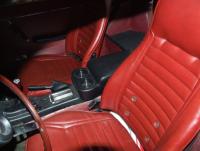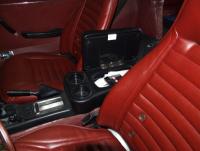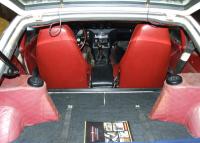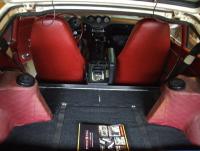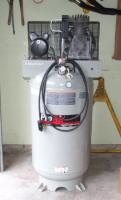Everything posted by DeesZ
-
PerTronix Electronic Ignition
The Pertronix works very well on my 1972 (4-speed). It was installed per their instructions with the ballast resistor. Ronald, check to see if there is any side-to-side play in your distributor shaft. Any slop there will present issues.
-
What worst car have you bought ever?
Absolute worst car ever that I have owned: 1979 Ford Mustang. It was a piece of cra* from day-one. My (now x) wife wanted it. I was quite pleased to send them into the sunset together. They deserved each other.
-
Help pricing my 240Z for sale...
Location makes a difference, too.... You'll get more in the east than on the west in USA. Where is Z-Land? Personally, I would spend those several hours of TLC that you suggest to maximize the sale price. One that 'runs/drives' will command a higher price than one that 'should run/drive'. Is your dash in pieces? How's the rust (how are the frame rails, floors, doglegs, spare tire well, etc)? All of this little stuff adds up one way or the other.
-
Antifreeze
I agree with the suggestions offered. Tight hose connections are important, but there are potential issues if the radiator hoses are 'over tightened'. I had a leak that turned out to be from over tightening the lower radiator hose. The PO put it on so tightly that it crushed the lower radiator outlet. I had to remove the radiator and reshape the outlet tube after I finally found the problem. Let us know what you find.
-
Fallout from a faulty voltage regulator.
I had a VR go bad on me and it burned out all lights (dash included) except the headlights. Actually it popped all circuits that were on at the time of the voltage spike. It was dusk and I had the parking lights on but not the headlamps. It also fried my fusible link..... battery croaked several months later. Check the bulbs and whatever else was "on" at the time as a starting place for your inspections.
-
Center Console Pad?
I agree with everyone that you are looking at an Amco aftermarket piece. I sold these back in the day.... And, yes, they pop up for sale at reasonable prices. The draw-back in my eyes is the drilling to mount them. Otherwise very nice (and honestly, the most "stable" one because of the secure mounting). IIRC, the local Datsun dealer sold Amco aftermarket accessories through their parts department (in addition to many other distributors such as the one where I worked). I wanted something in my '72, and after trying several options settled on the one pictured below. I cannot recall exactly where I got it - either eBay or MSA - but the manufacturer is identified in the pictures, and they are still in business. I like it because there are no modifications required to mount it, and it is very easily removable. I enjoy the fact that there are also several drink slots available, and it does hold a fair amount of stuff.
-
Hagerty and 240's
My opinion as well. This seems to be overlooked by some new owners.
-
I'm back in the game!!!
Welcome back to Z-cars! You are right, this is the place to be. Best of luck with the project. The Z provides a whole different type of motoring enjoyment than what a muscle car delivers. Keep us up to date, and dig in to the archives with the search function. You'll get lost there for countless hours. More Pictures!
-
radiator question
Yes, that is my preference as well. I have a very good rebuild shop who has been doing my work since the '70s. I am more comfortable with their rebuilds than I am with OEM or other source replacements. He also stands firmly behind his work.
-
Pomorza's Z threat.
The bolts look just like what you need. (I think the longer bolts also had washers on mine.) I just did water pump and radiator several weeks ago.
-
E88 Intake on a E48 heads
Just curious, is that an E48 or E46 tube. I went out to look at several I have sitting in the garage, picked two of them up and both seemed to read E48, but upon closer inspection they read E46. I don't seem to have an E48 among my mess of parts.
-
Air Compressors
Be patient with your shopping. It will come. I did the same shopping for my blasting cabinet. Patience paid off there well, too.
-
New Member--JoelZ
Welcome aboard! You must hook up with a friend of mine who visits the site every now and again..... Watch for user name "Racebird". Look him up and send him a PM. He lives in Allentown and is finalizing a really nice job on his 280Z. I'm not that far away either in Millersburg - maybe 90 miles or so. Enjoy that car!
-
Air Compressors
I am not an authority on compressors, but have learned a lot about them over the last several years. I decided to get a "larger" unit than the little one I got several years before. I did some research before getting one, and I'm glad that I did, because I am quite pleased with my purchase. Here's a few things that I've learned... anyone with corrections or additions, please post them. Air compressors are rated by horsepower, pressure, and cubic feet per minute (CFM) of output at a given tank pressure. Proper compressor sizing will provide you with suitable performance and longer compressor life (because you will not 'overwork' the unit). A good way to choose a compressor is to first decide which tools you are going to use with it; the compressor should exceed the CFM requirement of the largest tool you will use by probably at least 1.5 times. If you plan to run more than one tool at a time off the same compressor, add the CFM's of the tools together before multiplying by 1.5. Generally, your biggest draw on air will be tools like sanders, grinders, sandblasters, etc. They need a continuous flow of air and will need larger, more powerful compressors to meet the demand. Another issue to consider is what is known as the "duty cycle". The duty cycle is usually expressed as a ratio - how much time the compressor can safely run within a given period of time. A common "duty cycle" for compressors is 50%, meaning that the compressor should not run more than 50% of one hour... During the "on" time, the motor is pressurizing the tank. During the "off" time, your tools are running on the air stored under pressure in the tank. If your tools are draining the pressure off too fast, the compressor must run at more than 50% of the time that you have it in use. (With the 50% duty cycle the maximum pumping time per hour would be 30 minutes.) Horsepower ratings of electric motors can be measured several ways and the figures seem to have been abused by manufacturers over the years, so they are not a very reliable way to measure performance. The CFM and pressure ratings of an air compressor is, in my opinion, the best measure of how a compressor will meet your needs. I assume that you are looking at a piston type compressor. There are several types of those to consider..... single-stage and two-stage. Single-stage compressors usually have one or two pistons that compresses air and delivers it to the storage tank. The single-stage system is normally found on light or medium-duty compressors with a maximum rating somewhere below 150 pounds psi. Single-stage compressors are adequate for many of our needs. Two-stage compressors have two pistons that compress air. The first piston compresses the air and pushes it through a check valve to the second piston. The second piston further compresses the air and delivers it to your storage tank. The two-stage system is usually found on better heavy-duty compressors with maximum ratings above 150 psi. Two-stage compressors are good choices for heavy use environments. Then there is the decision to get an "oil-free" or "oil-lubricated" unit. Depending on what your needs are you may not have a choice. Oil free units require less maintenance, no oil changes, etc., but some people claim that they do make more noise and will not last as long. They are good for a lot of applications, and I know many happy users of that variety. I have very limited experience with oil-free units, and I have no complaints with them. "Oil-lubricated" units are most often found in more demanding environments. Some people claim that they are a bit quieter and that they last longer. Of course there is maintenance involved with oil changes. Personally I prefer the latter variety despite the maintenance (I have this 'thing' about parts rubbing each other without lubrication.... what can I say?) Any variety that you will get will be loud. I have never been around a quiet one, so consider 'placement' in your garage, and maybe some noise control. In my opinion, an absolute 'must' first step in noise control is adding vibration dampers to the feet (or mounting points where the unit meets the floor). Just get a good set before you even install a larger unit. Sticker price can be an eye popper for a nice unit, but don't skimp if you can possibly swing it. Consider what you may wish to use it for in the future, beyond your immediate needs. A good heavy-duty unit new will likely be between $900. ~ $1500. This is where patience can come in. I decided to look for a used well cared for unit. Found one (DeVilbiss brand) on eBay for $300.(plus a 150 mile drive) with about 50 hours of use - looks and performs like new, 80 gallon tank, oil-lubricated two-stage, and delivers 17.4 SCFM @ 100 psi & 16.9 SCFM @ 175 psi. I am very happy with the unit. I thought that it would exceed my demands very well. It has ended up just meeting my current demands with a media blasting cabinet. I'm very glad that I bought beyond my anticipated needs/requirements because I keep finding more ways to use lots of compressed air! I hope this helps you in your decision. I'm certain others will have good input as well. Here's a picture:
-
Cylinder head info
I recently had HLS30-023609 (engine # 030185) mfg. 02/71 that had an E88 head. I assumed it to be original, but that was, as I said, an assumption.
-
1971 240Z owner
Welcome aboard! You will enjoy driving a 240Z. I'm looking forward to hearing and seeing more.
-
Cylinder head info
Great. Now we need some pictures to look at! We really like pictures here.
-
Cylinder head info
Welcome! To ID the head type, check out the casting number that is found on the head just below and between plugs #1 & #2. See the picture attached of an E88 head. There are different heads out there, and a lot has been written up on them and the debate about which ones are better. Give us a production date and engine number and someone will likely be able to verify if it is what belongs on the car. The engine number is found on a flat cast into the block to the left and a bit below where you find the head casting number. My guess is that an L24 in a 1972 came with an E88 head. To verify if the engine is original to the car, check the block number against the data plate engine number found on the right hand strut tower in the engine compartment. I hope this helps. Attachment:
-
looking , need info
There are many, many threads of discussion on that topic within the archives on this site. You will have fun with the search function for that. Also, a good educational read can be found here: http://www2.zhome.com:81/ (Thanks Carl!) Look on the left of the page and click on "Z Ownership". I hope your search goes well. The more information you have up front will serve you well by reducing the potential pains caused by an uninformed impulse purchase. Please feel free to ask questions based upon what you find, and keep us posted on your search.
-
Got the 71 240z Partially Painted today
That's beautiful. I really like the color. I am anxious to see the final product! (What is the interior color?)
-
Pomorza's Z threat.
I agree with Stephen! Not to be a nit-picker, but I always thought it was called "water inlet". The gasket may be available separately, but again I agree that it would be an easy one to cut. I've never had a leakage problem with one at the gasket, so I would look closely to try to determine the origin of the leak in that area. If you need either the inlet/outlet piece or a radiator, I think I have both out in the garage. Both quite serviceable. Not certain if the inlet piece had many variations, but we could exchange pictures if need be. Both pieces came off on a 280Z, but I cannot recall which year. The rad was in use on my 240 until I recently replaced it with the correct smaller size for my application. Good luck with that and the project as a whole!
-
Newbie
Welcome aboard! I'm sure you will find most of what you are looking for through this board, including a lot of know-how.
-
Speedometer O-Ring Replacements - Tips Needed
FWIW, assure that you get the 'fill' plug loose prior to removing the drain plug.
-
Rear Drum Stuck????
Lots of tips within the archives... This thread is good for starters: http://www.classiczcars.com/forums/showthread.php?t=26392&highlight=brake+drum
-
Fender mirror measurements
Are these different than the ones discussed last May? http://www.classiczcars.com/forums/showthread.php?t=34355&highlight=Fender+mirror+measurements





